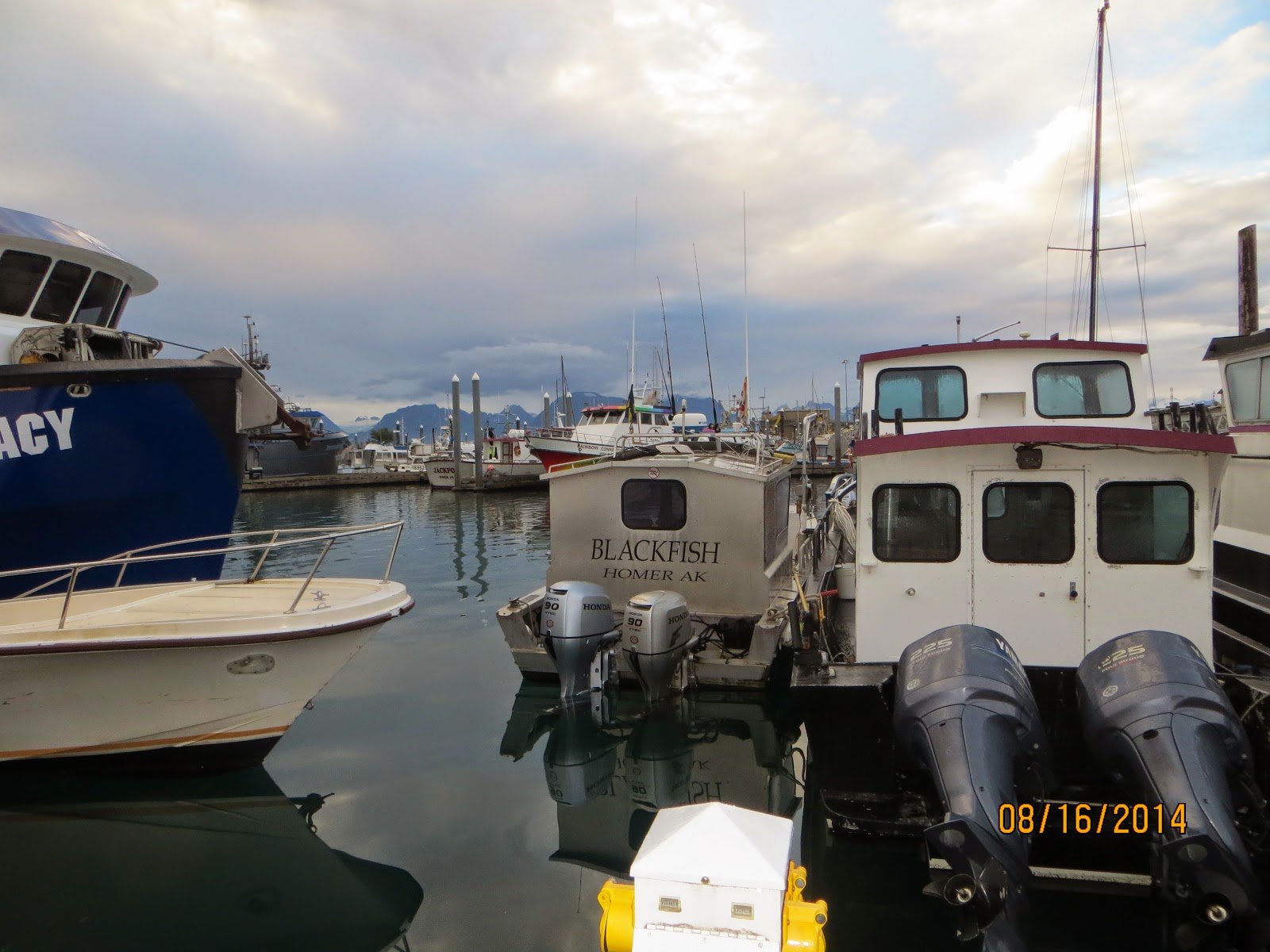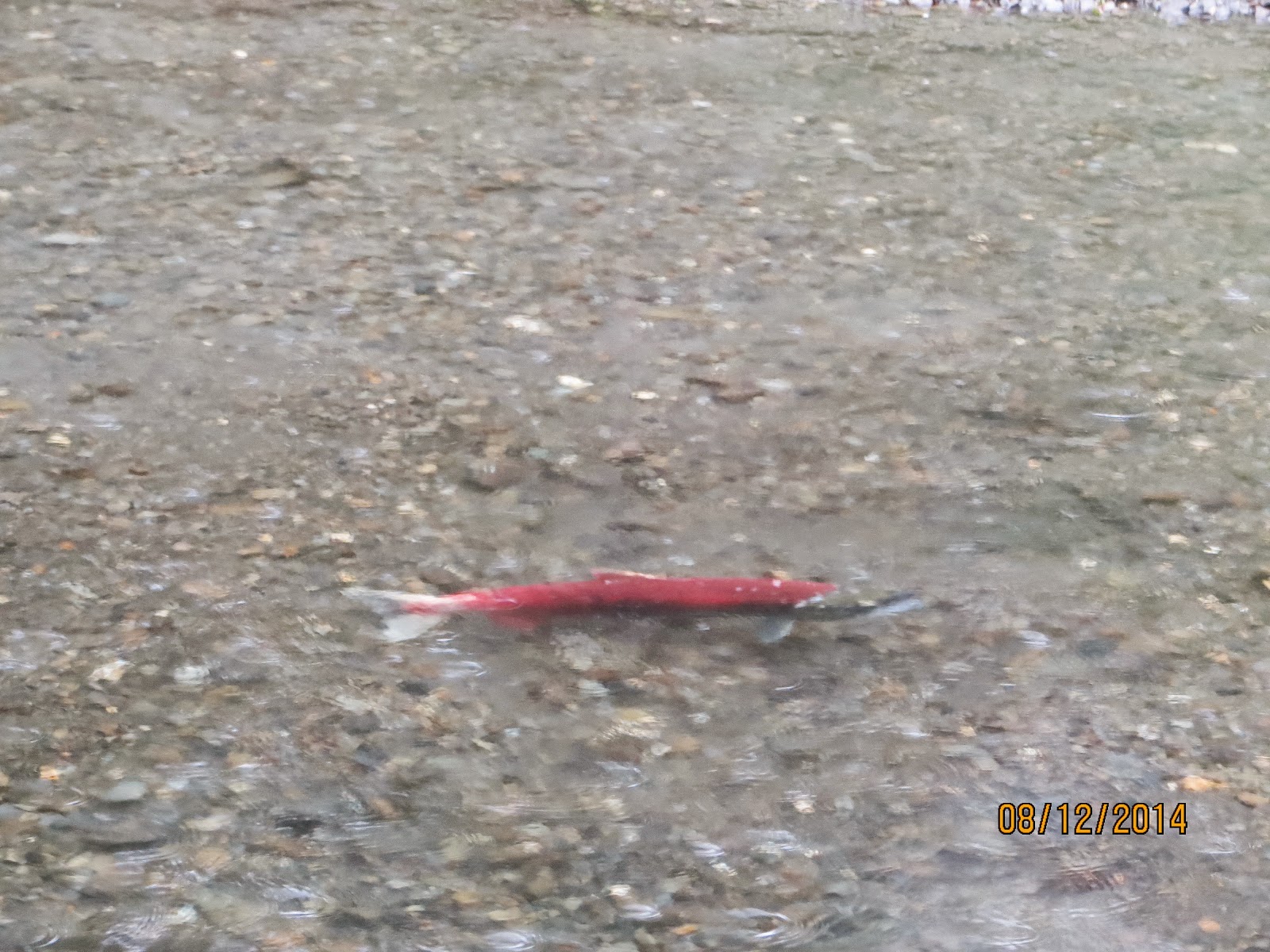Friday, August 22, 2014
Seldovia
One of the contacts that our tour operator, John, has owns a cottage on the outskirts of Seldovia, a small arts, fishing, native colony across Cook Inlet from Homer. It is about a 45 minutes in a water taxi.
Ours was the Blackfish and it was a welded aluminum structure built like a landing craft with a ramp that laid down in the front. He just ran us up on the beach and laid the ramp down and we walked out onto the shore. The fare for five of us was $225. Later, we returned on the ferry for $30 each.
The cottage is a lovely affair set on a spit with views to both sides of the site. The water out there doesn't freeze but he still shuts everything down in October and doesn't return until April. It's basically a weekend getaway that he flies down to on the weekend. It's located seven miles outside of the village and we took a ride in the car he keeps out there for the purpose. Lovely views abound.
We loaded the boat with bait and tackle and headed out 13 miles into the inlet to a hole that is popular with the local charter boats. When we got there we counted 16 boats in there ahead of us. But we were spread out over a mile or more so it wasn't crowded.
Halibut are bottom feeders and we fished for them something like I have done for bullheads. The bait, in this case herring chunks, is threaded on a circular hook and carried down to sit on the bottom by a weight. We were fishing in 220' of water so the weight was a one pound lead ball. The force of the tide motion would cause the boat to drift too fast to keep the bait in position so we timed our arrival at the hole to coincide with the slack tide. We had a window of about three hours and then the tide motion was too great and we had to pick up and return to port.
The motion of the boat drags the weight over the stoney bottom and the pole tip keeps dipping in response. It was easier to keep a hand on the rod to feel the action than it was to detect a bite by just watching the rod tip. After a while and several missed strikes and lost bait we started to get the feel of it. I was the first to have a good hit that stayed on and I reeled in my first halibut. In deeper water, they get really big. We saw a picture of one that weighed 466 lbs. and many of 100-200 lb. fish. Partly because we were in shallower water, ours were smaller but still about 20 to 40 pounds apiece. We were allowed to keep two each. Everyone caught fish and we threw some smaller ones back and ended up with five fish in the cooler.
They are not an especially attractive fish, nothing like a nice shiny salmon. Since they live on their side on the bottom, one side of them is dark and mottled to match the bottom and their other side is pure white. The young are born with their eyes in the normal position but in time the one closest to the bottom moves around so that both eyes face up when the fish is on its side.
Since we had about 250' of line out and were using an one pound weight to hold the bait to the bottom, reeling one in was quite the chore.
Once while we were repositioning we crossed a long line of floating debris and recovered this float. It had Japanese writing on it and our captain thought it must be part of the tsunami debris that has been showing up in the area.
As the tide became too strong to fish against we returned to the dock to empty the locker and clean our fish. All of the marinas and fish docks in this area have cleaning stations. Some are just a modest table while others can accomodate a dozen men or more and are equipped with running water in spray heads and waste tanks for the carcass. This was a medium size station but still well equipped. Our captain cleaned and filleted our catch.
We wound up with a pretty good cooler full of fillets.
Of course, there were interested onlookers.
We got back to the harbor about 2:30 and the ferry didn't leave until 4 so we had a chance to walk around the small village, see the sights and get some ice cream. On the way back in we saw this golden eagle working on a fish.
The town has a boardwalk a couple hundred yards long with some interesting sights and buildings.
It reminded me of walking through the harbor villages in Maine.
Woodwork is always in evidence. This newly constructed pavilion was eye catching with its post and beam construction.
Throughout the whole state we saw numerous examples of chainsaw sculpture that went way beyond eagles and bears and moose. These were in Seldovia.
Soon enough our ferry, the Rainbow Connection, was ready to sail and we ended another fantastic day.
Homer
After spending some time with friends at Soldatna, we headed down the penninsula in mixed weather to the community of Homer. We drove out to the last bit of land jutting out into Cook Inlet called Homer Spit. It's just sand and rock and it's about 200 yards wide and about four miles long. There are marinas and campgrounds and stores lining the sides.
On the way south, we had to stop at this store to look around. We've been stopping at second hand stores and pawn shops just for fun and this one sure was.
There is a lagoon on one side of the spit in which hatchery salmon are raised in cages and then released. This imprints them with the scent of the lagoon and they return there to spawn. Of course, these aren't spawning grounds and it's just a put and take operation to lure fishermen to the area. The season had just opened the day before we pulled in and the banks were packed with fishermen.
Since this is a meant-to-be-harvested population, the use of snagging hooks is legal and the novice and unskilled can catch fish alongside the more experienced fishermen. This season is famous locally and abroad and we saw many tourists and first time fishermen from abroad trying to bring something to land. Many had no clue what they were doing or what to do after they hooked a fish. It was both comical and sad. Our group managed to get a couple the next day so we continue to put fish in the freezer.
We camped right next to the water in a a small campground. One of the treats we discovered was that in the water right in back of our campsite, we could see sea otters and loons. The otters would dive in the shallow water and bring up something to eat and then roll over and float on their backs while they held their lunch on their bellies to eat.
We took a couple of days to explore the greater area including a short foray north to try the fishing at a place called Anchor River that we had been told was hot for Silvers but didn't work for us. On our way up to the river we stopped at a farmers market. This was a small one by most standards but it was purely a farmers market with a few local crafters. Everything home-grown and no junk. Local music to go with local muchies.
When I saw this belt buckle by a local scrimshander I just had to have it.
Back on the spit the weather promised to improve with a pretty sunset and harbor views.
Our final day in Homer was capped by a trip to Seldovia, across the bay and accessible only by water or air, for a boat ride into the inlet for a try at halibut fishing. But that will have to be a post of its own.
Seward
After spending several days seeing the major attractions in Anchorage, we started down the Kenai Penninsula. We were headed for Seward and then Soldatna, Homer and Seldovia. The weather turned wet and we had a week of clouds and showers and cooler temps.
On the way through the mountains to Seward we spotted a pull-over spot with a sign that said fish viewing. So, we donned our rain gear and followed a trail through the woods to a small stream where we saw sockeye salmon at the end of their spawning run.
We have had several opportunities to see the salmon on their journey and it's exciting to watch them charge upstream. The unfortunate reality is that these fish stop eating after they leave the salt water. They swim upriver to spawn and then their life is over. The upstream creeks are littered with the stark evidence of the completion of their journey.
We pressed on to Seward through the rain and found an overnite spot at the end of a small service road for the local air strip. The next day we went, again in the rain, to visit the town and look around. Seward is a very small community set in an almost fiord-like setting with gorgeous mountains all around. On a clear day it would have been spectacular. But we didn't have a clear day and had to make due with views such as the opening shot. Seward is a deep water port that serves as a terminus for several cruise lines and one was in port while we were there. There is a small strip of shops that serves a large marina. Seward is one access point to get to Prince William Sound which is known for its fishing and its glaciers. We didn't fish but we did get to see glaciers later in the week at Whittier.
The modern, well-appointed marina.
There was a Silver Salmon derby in progress that weekend and there were also many charter fishing boats going out. The Silvers were hitting well. Here is one couples' morning catch.
Outside of the fishing and the shops and restaurants, the one big thing to see in Seward is the Sea Life Research Center. It is a large aquarium and exhibit space that highlights the area species and the research being done to sudy them. It's very well done and has some excellent tanks and viewing opportunities. Here's a Stellars sea lion.
This guy was trim and slim at 1600 lbs. after his breeding season wieght of 2400 lbs. He had this tank to himself.
Artwork is plentiful in the seaside communties. This sculpture was outside the Sea Life Center.
Many communties also use murals to dress up and set a tone. Here are two we saw in Seward.
One of the charter offices also showed some creativity with the work on their siding.
We had parked at the marina and used a free shuttle to get around town. After the aquarium we stopped at a local restaurant for an early dinner of fresh halibut and cold beer. Not a bad day in spite of the weather.
Subscribe to:
Posts (Atom)


























































